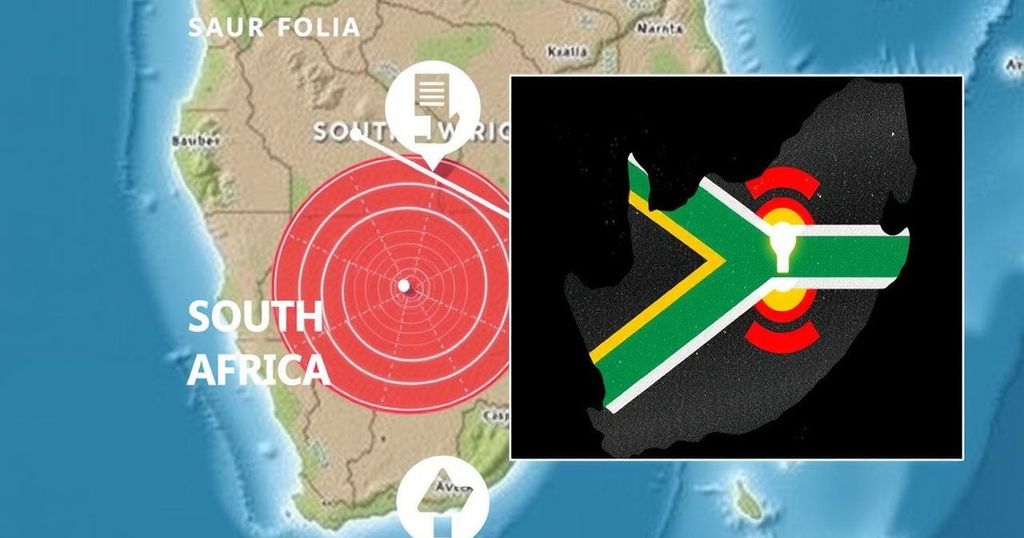Magnitude 5.3 Earthquake Strikes South Africa, Highlighting Preparedness Concerns
On December 22, 2024, a 5.3 magnitude earthquake shook South Africa, alarming residents and raising concerns about preparedness. Centered 101 kilometers west of Brandvlei in the Northern Cape, the tremor was felt as far as Cape Town. Fortunately, there were no reported casualties or severe damage, prompting discussions on enhancing infrastructure resilience and public safety measures.
On December 22, 2024, South Africa experienced a magnitude 5.3 earthquake that awakened residents at approximately 2:51 AM local time. The epicenter was recorded about 101 kilometers west of Brandvlei, in the Northern Cape, with a depth of 10 kilometers according to the United States Geological Survey (USGS). The quake was notably felt in Cape Town, roughly 250 kilometers from the epicenter, sparking alarm and highlighting the nation’s preparedness for seismic events. Fortunately, initial assessments reported no casualties or severe structural damage, although local authorities continue to evaluate the situation.
This earthquake is significant in a country where substantial seismic activities are infrequent. Residents reported mild to moderate shaking, with many expressing unease regarding the unexpected event. “It was terrifying. We weren’t ready for something like this at all,” a resident from the City Bowl area remarked. While classified as moderate, such events necessitate discussions about earthquake readiness, particularly regarding urban infrastructure and community awareness.
Experts assert that, notwithstanding the earthquake’s potential impact, South Africa’s urban planning and geological characteristics suggest resilience. Dr. Lesley Steyn, a geologist at the University of Cape Town, noted, “The reality is, South Africa needs to be more prepared for these occurrences, even if they are less frequent.” Despite the lack of severe consequences such as collapses, the tremor highlights the pressing need for infrastructure improvements and modern reinforcement strategies.
In the aftermath, scattered reports surfaced showing minor damage like fallen objects and wall cracks, giving rise to discussions on enhancing disaster preparedness. No tsunami warnings accompanied the tremor, which alleviated some fears among coastal communities. Historical data indicates a pattern of seismic occurrences in the region, including a notable quake in Orkney in 2014, underscoring the need for continuous vigilance.
Looking ahead, the focus shifts towards bolstering infrastructure and leveraging seismic monitoring systems to better predict future events. Emulating global best practices, such as Japan’s rigorous building codes and early warning platforms, South Africa can further enhance its preparedness. Community engagement through educational programs focussing on earthquake drills and response training will be pivotal in fostering resilience.
Furthermore, collaborative initiatives with international partners could lead to improvements in foundational safety measures. The recent earthquake has reignited conversations about disaster readiness, serving as a critical reminder for authorities to prioritize infrastructural integrity and public education regarding seismic safety. South Africa’s path forward must be defined by increased readiness and proactive strategies to effectively manage potential future seismic disturbances.
The occurrence of the December 22, 2024, earthquake in South Africa signifies an unusual yet crucial reminder of the country’s vulnerability to seismic events. Known for infrequent and typically low-magnitude earthquakes, this 5.3 magnitude quake demonstrated both the potential risks associated with such occurrences and the imperative for enhanced preparedness. Historical patterns and geological features necessitate attention to building codes, community education, and infrastructure resilience. Experts emphasize that the rare but impactful nature of seismic activities in South Africa warrants a reevaluation of disaster response strategies, ensuring that both public safety and structural integrity are maintained.
In summary, the magnitude 5.3 earthquake that occurred in South Africa on December 22, 2024, highlights important issues regarding the country’s earthquake preparedness and infrastructure resilience. While the absence of severe damage is reassuring, this event serves as a crucial reminder of the need for continuous improvement in safety protocols and community education. Proactive measures, including the establishment of seismic monitoring and strengthening disaster response frameworks, are essential to safeguarding public welfare against future seismic threats. A united effort between government, experts, and citizens will be vital in advancing South Africa’s readiness for potential seismic disturbances.
Original Source: evrimagaci.org




Post Comment